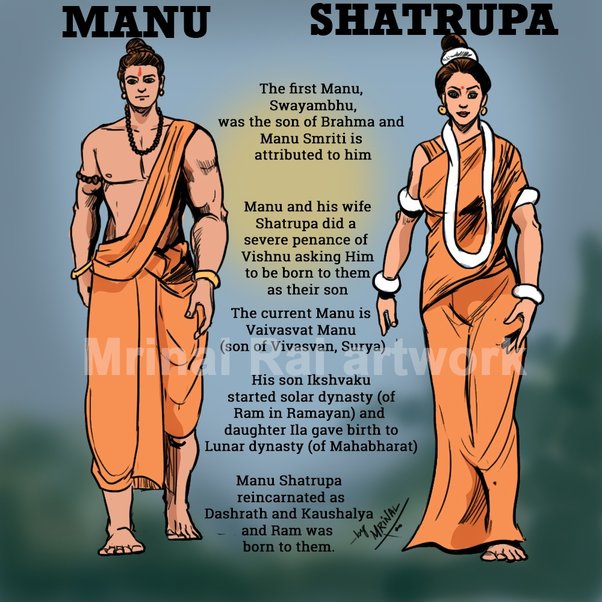Manu & Shatarupa – first human on earth

Swayambhuva ‘Manu’ also called Adi. ‘Adi’ means beginning. Man, Manuj, Manav, Aadam, Aadmi, etc. all the words spoken by humans in all languages are influenced by the word Manu. He is the first messenger of all mankind. There are many reasons to consider him the first. The first man of the world was Swayambhuva Manu and the first woman was Shatarupa. All the people of the world originated from the children of this first man and first woman. Being the son of Manu, they were called Manav.

Manav from Manu
Human is more active than matter and life – mind. Man has the power of mind, the power to think, that is why he is called man. Since all these are the children of ‘Manu’, that is why man is also called Manav.
Seven Manus
In the Hindu religion, in the family of Swayambhuva Manu, there were 7 Manus including Swayambhuva respectively and 7 remain to be. There is mention of 8 Manus in Mahabharata. There is mention of 14 Manus in Shvetavarah Kalpa. Only these fourteen Manus have been called Kulkar in Jainism.
Names of Fourteen Manus
1.Swayambhu, 2.Swarochish, 3.Auttami, 4.Tamas Manu, 5.Raivat, 6.Chakshusha, 7.Vaivasvata, 8.Suryasavarni, 9.Daksha savarni, 10.Brahma savarni, 11. Dharma Savarni 12. Rudra Savarni, 13. Rauchya or Dev Savarni, 14. Bhaut or Indra Savarni.
Son and daughters of Manu and Shatarupa
In Prajapatya Kalpa, Brahma manifested Rudra form as Swayambhu Manu and Shatarupa in female form. Swayambhuva Manu and Shatrupa had a total of five children, out of which two sons were Priyavrata and Uttanpad and three daughters were Akuti, Devhuti, and Prasuti. Aakuti was married to Ruchi Prajapati and Prasuti was married to Daksha Prajapati. Devahuti was married to Prajapati Kardam. A son was born to Ruchi, who was named Yagya. His wife’s name was Dakshina. Kapil was the son of Rishi Devhuti. According to Hindu Puranas, the human beings of the world increased with these three girls.
Further increase in generations
Daksh gave birth to 24 girls from childbirth. Its names are Shraddha, Lakshmi, Pushti, Dhuti, Tushti, Medha, Kriya, Buddhi, Lajja, Vapu, Shanti, Riddhi, and Kirti. Terah was married to Dharma and then Bhrigu to Khyati, Shiva to Sati, Marichi to Sambhuti, Angira to Smriti, Pulastya to Preeti to Pulah to Kshama, Kriti to Sannati, Atri to Anasuya, Vashisht to Urja He married Ka, Vahva to Swaha and Pitris to Swadha. The future world developed from these only.

Two sons- Priyavrat and Uttanpad
Uttanpad had two wives named Suniti and Suruchi. Suniti of King Uttanpad had a son named Dhruva and Uttam from Suruchi. Dhruv achieved a lot of fame.
Priyavrat, the second son of Swayambhuva Manu, had married Vishwakarma’s daughter Bahirshmati, from whom ten sons like Agnidhra, Yagyabahu, and Medhatithi were born. From Priyavrat’s second wife Uttam Tamas and Raivat – these three sons were born who became the rulers of the Manvantars of their names. Among the ten sons of Maharaj Priyavrat, Kavi, Mahavira, and Savan, these three were moral celibates and they had taken the religion of sannyasa.
Rule of Manu
Maharaj Manu ruled this Saptadweepavati earth for many days. People were very happy in his kingdom. He had composed ‘Manu Smriti’ which is not found in its original form today. Its meaning has been causing disaster. In those days, varna meant color, and today caste.
Following the people, when Maharaj Manu desired salvation, he handed over the entire kingdom to his elder son Uttanpad and went on the Naimisharanya pilgrimage in solitude with his wife Shatrupa, but the fame of his second son King Priyavrat was more than that of Uttanpad.
Manu did penance for a hundred years on the banks of the Sunanda River. Both husband and wife did penance for a long time on the banks of Gaumati in the holy pilgrimage named Naimisharanya. The tombs of both are built at that place.
The sages of the time of Swayambhu Manu were Marichi, Atri, Angiras, Pulah, Kritu, Pulastya, and Vashishtha. The said sages along with King Manu did the work of making humans civilized, comfortable, laborious, and cultured.
Kindom of Manu
King Priyavrat’s eldest son Agnidhra became the ruler of Jambudweep. The nine sons of Agnidhra are considered to be the masters of the nine parts of Jambudvipa, whose names according to their names are Ilavrit Varsha, Bhadrashva Varsha, Ketumal Varsha, Kuru Varsha, Hiranyamaya Varsha, Ramyak Varsha, Hari Varsha, Kimpurush Varsha and from the Himalayas to the sea.
The region is called Nabhi Khand. Nabhi and Kuru, both these years have been described as having the shape of a bow. Rishabh was the son of Nabhi and ‘Bharat’ was born in Rishabh. In the name of Bharat, later this navel section came to be known as Bharatvarsha.
You must be thinking that when Swayambhuva Manu was the first human on earth, where did the other Rishis, Prajapati, etc come from? There were many divisions of this earth in ancient times. Underworld, earth, heaven, etc. It was from heaven itself that Brahma brought down Swayambhuva Manu on earth. The stories of his incarnation are different.